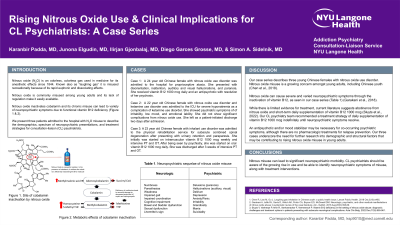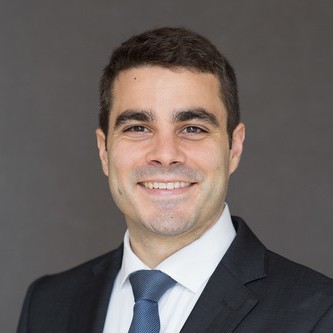Substance Use and Related Disorders
Session: Poster Session
(178) Rising Nitrous Oxide Use and Clinical Implications for C-L Psychiatrists: A Case Series

Trainee Involvement: Yes

Karanbir Padda, MD
Assistant Professor of Clinical Psychiatry
New York-Presbyterian/Weill Cornell Medical Center
Brooklyn, New York, United States
Junona Elgudin, MD
Assistant Professor of Psychiatry
Mount Sinai Beth Israel
Astoria, New York, United States- IG
Ilirjan Gjonbalaj, MD
Consultation-Liaison Psychiatry Fellow
NYU
New York, New York, United States 
Diego Garces Grosse, MD
Clinical Assistant Professor
NYU Langone Health
NY, New York, United States
Simon A. Sidelnik, M.D.
Director Addiction Consultation-Liaison Psychiatry
NYU Grossman School of Medicine
New York, New York, United States
Presenting Author(s)
Co-Author(s)
Chen R, Liao M, Ou J. Laughing gas inhalation in Chinese youth: a public health issue. Lancet Public Health. 2018 Oct;3(10):e465. Garakani A, Jaffe RJ, Savla D, Welch AK, Protin CA, Bryson EO, McDowell DM. Neurologic, psychiatric, and other medical manifestations of nitrous oxide abuse: A systematic review of the case literature. Am J Addict. 2016 Aug;25(5):358-69. Sluyts Y, Vanherpe P, Amir R, Vanhoenacker F, Vermeersch P. Vitamin B12 deficiency in the setting of nitrous oxide abuse: diagnostic challenges and treatment options in patients presenting with subacute neurological complications. Acta Clin Belg. 2022 Dec;77(6):955-961.
Background: Nitrous oxide (N2O), commonly used as an anesthetic agent and aerosol propellant, is an easily accessible inhalant that produces rapid euphoric effects when misused. N2O misuse has increased globally amongst young adults and can lead to significant morbidity due to its neuropsychiatric manifestations. We present three patients admitted to the hospital with N2O misuse to delineate the demographics and spectrum of neuropsychiatric presentations encountered by consultation-liaison (CL) psychiatrists. We additionally describe a different treatment strategy for neuropsychiatric symptoms of N2O use from what is currently suggested in the literature.
Case: We present a series of three cases of patients with N2O use disorder admitted to a tertiary center that were seen by our CL psychiatry service in the short span of December 2022-January 2023. Patients ranged in age from 22-24 and were all females of Chinese descent. One patient suffered from comorbid ketamine use disorder and did not show significant complications of N2O use. The other two patients demonstrated proprioceptive ataxia, subacute combined degeneration, paraparesis, urinary retention, delirium, auditory and visual hallucinations, paranoia, depressed mood, and irritability. These two patients were initiated on vitamin B12 1000 micrograms (mcg) weekly, and later increased to 1000 mcg daily at the recommendation of our service. One of these patients also received an antipsychotic for treatment of psychosis. Neuropsychiatric symptoms improved with these interventions.
Discussion: Our case series describes three young Chinese females with N2O use disorder. N2O misuse is a growing concern amongst young adults, including Chinese youth (Chen et al., 2018). N2O can cause severe and varied neuropsychiatric symptoms through the inactivation of vitamin B12, as seen in our case series (Garakani et al., 2018). While there is limited evidence for treatment, current literature suggests abstinence from N2O and short-term daily supplementation of vitamin B12 1000 mcg (Sluyts et al., 2022). Our CL psychiatry team recommended a treatment strategy of daily supplementation of vitamin B12 1000 mcg indefinitely until neuropsychiatric symptoms resolve. An antipsychotic and/or mood stabilizer may be necessary for co-occurring psychiatric symptoms, although there are no pharmacologic treatments for relapse prevention. Our three cases underscore the need for further research into demographic and structural factors that may be contributing to rising N2O misuse in young adults.
Conclusion: N2O misuse can lead to significant neuropsychiatric morbidity. CL psychiatrists should be aware of the growing rise in use and be able to identify neuropsychiatric symptoms of misuse, along with treatment interventions.
References:

